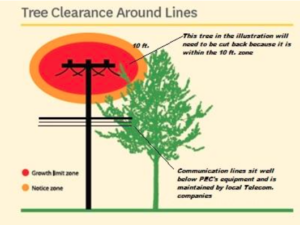Home » Vegetation Maintenance » Vegetation Maintenance Standards
Vegetation Maintenance Standards
PEC’s vegetation maintenance (VM) department follows industry-wide vegetation standards to provide safe, reliable service to our members.
ANSI Z-133 is the American National Standard for Arboricultural Operations, which includes safety requirements for brush cutting, pruning, repairing, maintaining, and removing trees. Documents from these requirements are referenced when identifying safety violations of personnel engaged in utility vegetation maintenance work. Therefore, it is considered the definitive safety standard for arboricultural operations by which PEC’s vegetation maintenance department abides.

ANSI Z-133 defines an electric hazard to exist anytime a tree worker, tool, tree, or any other conductive object is closer than 10 feet from an energized conductor with a voltage of 50,000 volts or less. This drives our commitment to safely maintain a 10-foot clearance from electric lines with our cyclical feeder maintenance (see image). ANSI Z-133 provides tables that outline minimum approach distances for both qualified and non-qualified tree workers based on voltage and elevation.
ANSI A300 standards are the generally accepted industry standards for tree care practices. Pedernales Electric Cooperative and its approved vendors abide by these performance standards to promote healthy growth away from electric lines, embody professionalism, improve communication and education to our membership, and eliminate hazards. The A300 standards consist of 10 parts from which PEC has developed pruning standards, integrated vegetation management and tree risk assessment practices.
OHSA 1910.269 is the Occupational Safety and Health Administration’s vertical safety standard pertaining to the generation, transmission, and distribution of electricity. A specific section of OHSA 1910.269 requires that everyone performing tree work in proximity to electric hazards must be trained and qualified to distinguish exposed live parts from other parts of electric equipment, 1910.269(a)(2)(iii)(A,B,C).
Qualifications also include skills necessary to determine minimum approach distances specified in this section corresponding to the voltages to which the employee will be exposed and the skills and techniques necessary to maintain those distances.
All PEC trimming contractors are trained and qualified to determine minimum approach distances and are certified to work within those distances. This ensures the right pruning methods are performed safely within our service area.
The VM department adheres to Chapter 752 – High Voltage Power Lines, specifically 752.004, which prohibits all activities in which persons or equipment may come within 6 feet of energized overhead lines. Only qualified employees of an electric utility can perform any activity within 6 feet of the overhead high voltage line (lines in excess of 600 volts). Contractors working directly for the utility are considered qualified. Non-qualified individuals must first make arrangements with PEC to mitigate the hazard and then schedule a line clearance to perform their tasks.
The Tariff and Business Rules of PEC include as a condition of service the requirement that a member provide access to PEC to perform vegetation management, among other conditions. Any failure to provide access may result in suspension of electrical service.